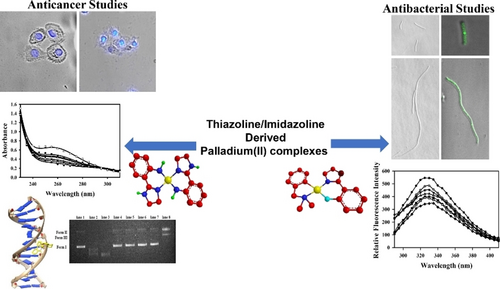Investigation on the Anticancer and Antibacterial Mechanism of Thiazoline/Imidazoline Derived Palladium(II) Complexes
Abstract
Biological activities of a series of palladium(II) complexes (M1–M9) bearing N∩N, N∩S, and N∩O chelating ligands are reported. The palladium complexes were tested for their cytotoxic properties against human cervical cancer (HeLa) cells and antibacterial activity against Gm+ve and Gm–ve bacteria. Among the palladium complexes studied (M1-M9), the complex M5, M8, and M9 were found to be more effective in inhibiting the proliferation of HeLa cells. Hence, these complexes were further investigated for their potential role in cellular damage and apoptosis. DCFDA staining, Rhodamine 123 staining and DNA cleavage assay revealed that complex M5, M8 and M9 induced apoptotic cell death in HeLa cells through ROS generation, DNA damage and mitochondrial depolarization. Computational and titration studies also indicated strong electrostatic interaction with DNA groove. Most of the complexes exhibited good antibacterial activity against both Gm+ve and Gm−ve bacteria. The antibacterial activity of the compounds could not be correlated with their anticancer activity indicating a differential mechanism at their effective concentrations. The detailed study on the antibacterial mechanism of the most potent complex M7 revealed that it exerted its antibacterial activity by inhibiting the function of FtsZ and perturbing the localization of the Z-ring at the mid cell.
Graphical Abstract
Conflict of interest
The authors declare no conflict of interest.
Open Research
Data Availability Statement
The data that support the findings of this study are available from the corresponding author upon reasonable request.





